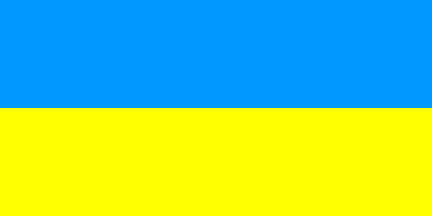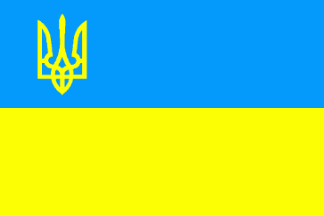 (2:3)
(2:3)
image by Antonio Martins, 17 December 2002

Last modified: 2016-02-09 by andrew weeks
Keywords: ukraine | europe | commonwealth of independent states |
Links: FOTW homepage |
search |
disclaimer and copyright |
write us |
mirrors
 (2:3)
(2:3)
image by Antonio Martins, 17 December 2002
Official Name: Ukraine (Ukrayina)
Previous Names: Ukrainian National Republic,
Ukrainian State, Ukrainian Soviet Socialist Republic
Capital: Kyiv
Location: Eastern Europe
Government Type: Republic
Flag adopted: 28
January 1992
Coat of Arms adopted: 3 September 1996
ISO Code: UA
From <www.ukraine.online.com.ua>:
"The Constitution states that the national symbols of
Ukraine shall be the National Flag, the National Emblem and the
National Anthem.
The Ukrainian flag consists of two horizontal stripes of equal
width. The top is blue, the bottom - yellow. Blue and yellow, the
colors of the sky, mountains, streams, and golden fields have
symbolized Kyivan Rus' long before the introduction of
Christianity. With the acceptance of Christianity, blue and gold
were incorporated into church symbolism. After the Mongol-Tatar
invasion in the 1200's the use of blue/gold was interrupted, to
be revived again in church ornaments and city crests some time
later. The emblem of the city of Myrhorod, for example, was a
gold trident over a blue background. Another city, Pryluky, used
the head of an ox in gold over a blue background as its insignia.
And in Lubny, the city emblem pictured a hand holding a golden
mace over a blue background. The banners of the Cossacks (17th
Century) were blue with gold stars, a gold cross, or with
pictures of saints rendered in gold.
The blue and yellow flag as the national flag of Ukraine by the
Supreme Rada in 1992."
Dov Gutterman, 10 July 2000
The blue-yellow flag was firstly displayed in Lviv (Lvov,
Lemberg) in 1848. Orenburg, for example, have blue-yellow CoA
too, But it is not in Ukraine. Banners of Cossacks were
different: blue, red, dark-red, green and other.
Victor Lomantsov, 10 July 2000
In Sweden there is a story going around, stating that the blue
and yellow of Ukraine come from the blue and yellow of Sweden.
When King Carl XII of Sweden (he was king 1697-1718) went to war
against Peter the Great of Russia, he made allies with the
Ukranians, who wanted sovereignity from Russia. The Ukrainians
should therefore have taken up the colours of Sweden as their
colours. However, I don't know if there is any truth in this
story.
Elias Granqvist, 10 July 2000
Official text say: BLUE (sinij (rus.) , syni (ukr.)).
Unofficially, especially in 1980ths, the colour was light-blue
(goluboj
(rus), blakitnyj (ukr)).
Victor Lomantsov, 19 December 2002
According to Album 2000 [pay00]
- National Flag and Naval Jack (CSW/CS- 2:3) - Light blue over
yellow bicolour.
Željko Heimer, 10 May 2003
Ukrainian state flag was adopted on January 28, 1992 by Decree
No 2067-XII of the Verkhovna Rada (=Supreme Council =
Parliament). Other dates (January 21, 1992; September 3, 1996)
are incorrect. Now the Ministry of Justice prepared new project
of law about the State symbols of Ukraine. But it isn't still
adopted.
Resolution of September 4, 1991 gave only possibility to use
Ukrainian National (blue and yellow) flag during the official
ceremonies - before the addopting of new State flag. Please note,
in former USSR we had the term "State flag". So, in
that case "National flag" was not a "State".
But final Decree, named "About the State flag of
Ukraine" was adopted on January 28, 1992. Number of Decree
is 2067-XII. Official publication in "Vidomosti Verkhovnoyi
Rady Ukrayiny" (Official bulletin of the Supreme Council of
Ukraine) was in No. 19 (1992), article 257.
4 September 1991 is the date when blue and yellow flag was first
flew at the building of the Supreme Council in Kyiv (together
with flag of the former Ukrainian SSR). But Decree of the
Presidium of Supreme Council about using of blue and yellow flag
was adopted on September 18, 1991 (No 1567-XII). Literally in
text: "Allow to use blue and yellow flag in all official
ceremonies untill the adopting of Constitution of Ukraine".
This Decree doesn't include ratio or other details of flag.
De-facto, it abolished former State flag of the Ukrainian SSR,
and proclaimed a blue and yellow as temporary official flag.
Decree of January 28, 1992 proclaimed a blue and yellow as the
State flag of Ukraine.
Andriy Grechylo, 24 March 2004
Darker or lighter colours of Ukrainian flag haven't any
political significance. According the legislations we have SYNIY
(blue) and ZHOVTYI (yellow) colours, but our society also accept
darker (for example - marine blue) or lighter (ligth blue)
colours.
Andriy Grechylo, 28 November 2004
In his role as the current President of the Council of
Ministers of the European Union, British Prime Minister Tony
Blair has been touring eastern European capitals to try to
resolve the problems with the E.U. budget. A report on 'The
World' last night on BBC4 showed him speaking at a meeting in a
location which wasn't specified, but, from the panel on the wall
behind him, was clearly connected with Ukraine if not actually in
that country. I was struck by the colours of the Ukrainian flag
next to the E.U. one in this photo.
There may indeed be no political significance to the colours, at
least in an internal Ukrainian party sense, but I can't help
feeling that their similarity to the dark blue and gold of the
E.U. flag isn't a coincidence!
Andre Coutanche, 2 December 2005
For Ukraine: PMS 2935 blue and process yellow. The vertical flag is simply
the horizontal version turned 90 degrees anti-clockwise
Ian Sumner, 11 Oct 2012
See also: Origins and History
The Open Media Research Institute reported that on 3 September 1996 the Ukrainian Parliament (Verkhovna Rada) had approved the country's national symbols as specified by the constitution [OMRI, #171, 1996]. Parliament also decided to organise a competition on the design of the state arms and the words of the national anthem. The 'tryzub' (trident) is the state arms, and the competition will decide the details of the design. The new constitution was adopted by Parliament 28 June 1996 (the date was declared a national holiday) and only confirmed the national symbols that were already in use [OMRI, #204, 1996]. OMRI offered no details on the action of the parliament, nor did they give any descriptions of the symbols. Article 20 of the constitution states that the 'The description of the state symbols of Ukraine and the order of their use is determined by law' [IFES]:
"ARTICLE 20.
The state symbols of Ukraine are the State Flag of Ukraine, the
State Emblem of Ukraine and the State Anthem of Ukraine. The
State Flag of Ukraine is a banner made from two equal horizontal
blue and yellow fields. The Great State Emblem of Ukraine shall
be determined in accordance with the Small State Emblem of
Ukraine and the Emblem of the Zaporiz'ke Viys'ko (Zaporizhzhya
Cossacks Army) by law, which shall be adopted by no less than
two-thirds of the Constitutional membership of the Verkhovna Rada
of Ukraine. The main element of the Great Emblem of Ukraine is
the Sign of the State of Prince Volodymyr the Great (the Small
State Emblem of Ukraine). The State Anthem of Ukraine is the
national anthem with the music of M.Verbytskiy and words,
confirmed by law, which shall be adopted by no less than
two-thirds of the constitutional membership of the Verkhovna Rada
of Ukraine. The description of the state symbols of Ukraine and
the order of their use is determined by law, adopted by no less
than two-thirds of the constitutional membership of the Verkhovna
Rada of Ukraine. The capital of Ukraine is City of Kyiv."

image by Antonio Martins, 17 December 2002
proportions: 1:2
Ukraine declared independence from the USSR on 24 August 1991. MPs celebrated the event by carrying a huge light blue and yellow flag through the assembly hall of the Parliament [Ukrainian Weekly, 1996]. Ukrainians approved the independence proclamation in a referendum held 1 December 1991. Provisional legislation [W. Smith, 1992] concerning the flag was adopted on 4 September 1991, with opposition from the Communists. This legislation therefore also made the Soviet era flag official, and the two flags were hoisted side by side (even on the same flag pole). The light blue over yellow flag was in proportions 1:2. The situation was changed 21 January 1992, when the light blue and yellow flag became the only flag of Ukraine. The proportions of the flag were then set to 2:3. The trident arms were adopted on 19 February 1992 [W. Smith, 1992].

image by J. Patrick Fischer, 24 November 2004
I saw today in German TV ZDF this variation of Ukrainian
national flag with the national symbol in the left upper corner.
The flag was on a demonstration against the "results"
of the presidental election.
J. Patrick Fischer, 24 November 2004
Today I saw on TV the 1:2-version of this flag. The flag of
yesterday has really 3:5. The yellow of the logo is the same as
the yellow of the stripe.
J. Patrick Fischer, 25 November 2004
This variation of Ukrainian flag was in project of the New
Constitution (1997). But finally the Parliament (Verkhovna Rada)
accepted our proposal - without image in the left upper corner.
So, some people use variations of national flag (with Trident at
shield or with Trident) during holidays, meetings etc.
Dr.Andriy Grechylo, 25 November 2004
I have taken a couple of photos of the Ukrainian demonstration in Munich on 7 Feb 2015. (https://groups.yahoo.com/neo/groups/FLAGS/photos/albums/730714280)
In addition to the plain bicolour there were several versions of the national flag either with the plain trident or with the trident in a shield:
On
this page a variant of the flag of Ukraine is shown with an incorrect version of
coat of arms in canton: the colors are reversed and a white border
added all around.
Tomislav Todorović, 4 Aug 2015